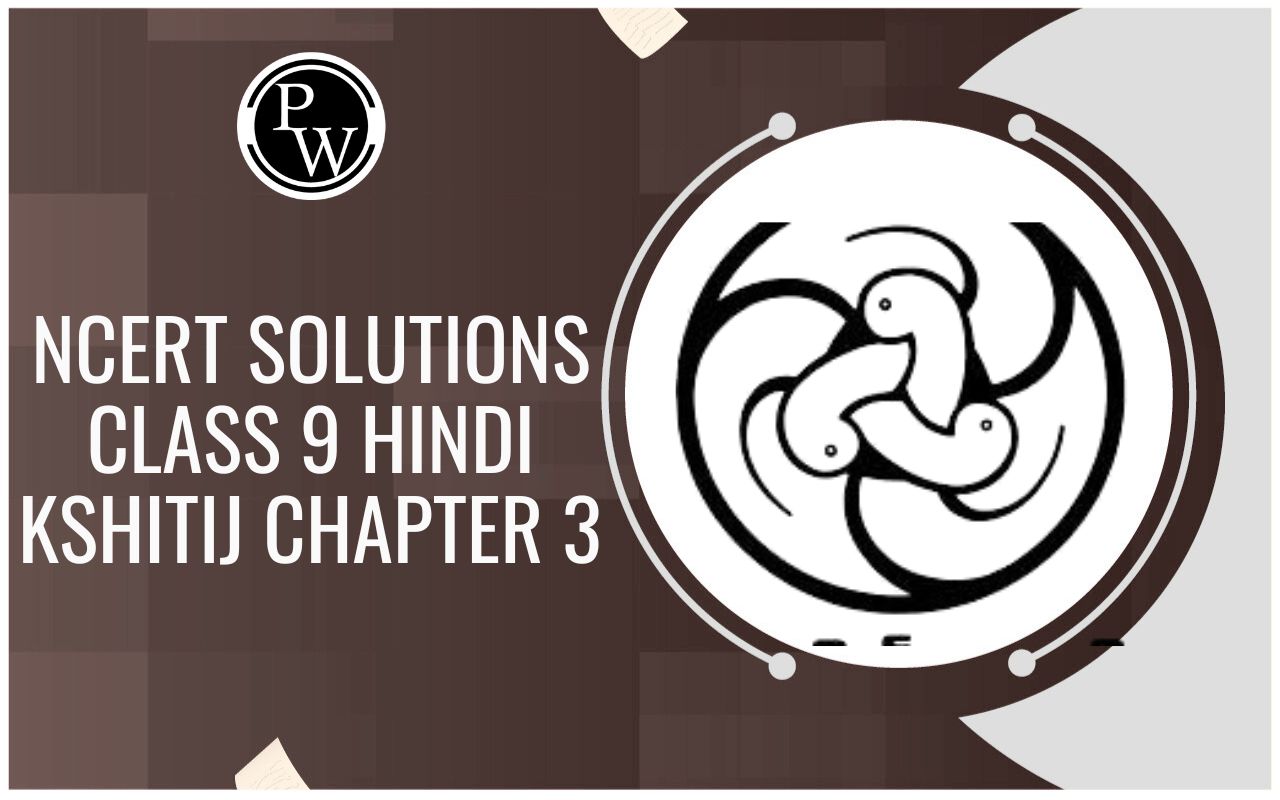
Environment Factors
Organisms And Their Environment of Class 12
Physical environment consists of factors like air, light, heat, water, soil and wind. These abiotic factors determine the success of an organism through their effect on structure, life-history, physiology and behaviour. Growth and reproduction of an organism are also affected by biotic factors, which include all other organisms in the habitat.
TYPES OF ENVIRONMENTAL FACTORS
The ecological factors (components of the environment) have been grouped variously by different ecologists. Sometimes all the factors are classified into two major groups :
- Direct factors
- Indirect factors
Direct factors : These factors influence the organisms directly e.g. light, temperature, humidity, soil, moisture, soil nutrients and soil air etc.
Indirect factors : These factors affect organisms indirectly by modifying other factors. e.g. soil structure, precipitation, wind, soil organisms, altitude, slope etc.
Environmental factors are divided into two categories on the basis of their nature.
- Abiotic factors
- Biotic factors
Abiotic factors : These include the non-living physico-chemical factors of environment. These are divided into the following categories :
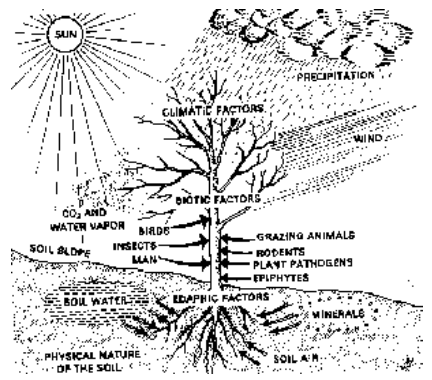
Fig. : Environmental factors
Climatic Factors (weather). These include the physical factors of environment like :
- Light
- Temperature
- Humidity
- Wind
- Rainfall
- Water
- Atmospheric gases
Edaphic factors
- Mineral matter
- Organic matter
- Soil water
- Soil air
Topographic factors
- Altitude
- Steepness of slope
- Direction of slope
Biotic factors
- Bacteria Algae
- Fungi Parasites
- Saprophytes Symbionts and Animals
A brief account and role of various factors in physical and biological processes is given below.
ATMOSPHERE
Gaseous envelope surrounding the earth is called atmosphere. Several concentric layers can be identified in vertical profile of atmosphere. Density, temperature and composition differs in these layers. Near the earth’s surface, density is highest and with increase in latitude density decreases.
These spheres are :
- Troposphere
- Stratosphere
- Mesosphere
- Thermosphere
Troposphere: The basal part of atmosphere which is about upto 20 km. above the earth’s surface (on poles only upto about 8 km.) is known as troposphere. For organisms this is the most important zone of the atmosphere. The important events, such as cloud formation, lightening, thundering, thunder storm formation, all take place in troposphere. Air temperature in this zone gradually decreases with height at the rate of about 6.5ºC per km. Towards the upper layers of troposphere, the temperature might decrease upto - 60ºC, and this limit of troposphere, which gradually merges into the next zone, is known as tropopause. Besides gases it contain dust particles, smoke, dust, pollen, spores and is characterised by weather changes cloud formation and is a medium for flying animals.
Stratosphere: Next to troposphere, the second zone of about 30 km. height, is called stratosphere, where the temperature values show an increase up to 90ºC. This increase in temperature is due to ozone formation under the influence of ultra-violet component of sunlight. Upper layers of stratosphere form stratopause.

Due to continuous production of ozone, harmful UV rays absorbed by ozone layer which is forming on ozonosphere within stratosphere and thus stratosphere serve as shield to protect components of troposphere. Stratopause is the upper limit of stratosphere.
Mesosphere: Beyond stratosphere, it extends upto an altitude of 80 km and shows a decrease of temperature with height. Mesopause is transitional layer between mesosphere and thermosphere.
Thermosphere (Ionosphere): The rest above the mesosphere, upto the height of above 300 km. above earth’s surface is ionosphere. Most of gaseous components which become ionised under the influence of radiant energy, remain as ions. Due to their much less density, they are rarely present in molecular form. Thus radiant energy brings about considerable changes in the atmosphere. Water vapour in the atmosphere affects the temperature and light intensities of atmosphere. Ionosphere protects earth from cosmic rays.
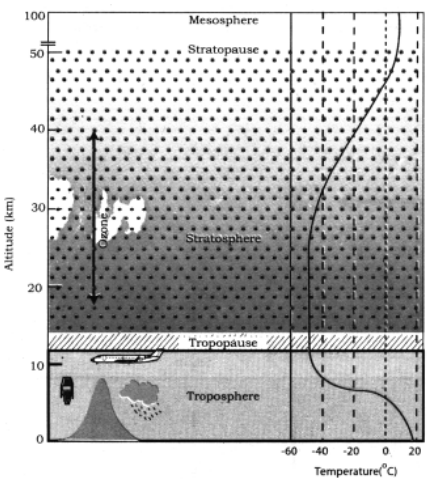
Fig. : The Biosphere and stratification in atmosphere
The atmosphere is an insulating blanket around the earth. It is source of essential gases, maintains a narrow difference of day and night temperatures and provides a medium for long-distance radio communication. It also acts as shield around the earth against lethal UV radiations and meteors. Without atmosphere, there will be no lightening, no wind, no clouds, no rains, no snow and no fire.
Normal composition of clean air at or near sea is as follows :
- Nitrogen 78.084
- Oxygen 20.9476
- Argon 0.934
- Carbon dioxide 0.0314
- Methane 0.0002
- Hydrogen 0.00005
- Other gases minute
The composition of the atomosphere is a product of the activities of living organisms. 98.9% is occupied by Nitrogen and Oxygen. The remaining 1 percent in Argon, Water vapour, Carbon dioxide, Ozone and other gases which are necessary for maintaining life on the earth. Water vapour absorbs infrared radiation from the earth and regulates the hydrological cycle sustaining life in both terrestrial and an aquatic ecosystem.CO2 water vapour and ozone play an important role in maintaining the heat balance of the earth.
GASES IN WATER
In the aquatic systems, oxygen, carbon dioxide, and other gases are partially dissolved in water. Oxygen may be a limiting factor for the growth of phytoplankton and other aquatic organisms, generally in deep lakes, or in waters receiving heavy load of organic materials. The oxygen supply in water is regulated through diffusion from the air and from photosynthetic activity of aquatic plants.
LIGHT
Light is essential for life. Amount and duration of light needed for different organisms varies. Most animals and some protists have special photoreceptors to seek proper light. Prolonged exposure to light stronger or weaker than required may be harmful. Light influences the populations in many respects.
SOURCE OF ENERGY
Sunlight is the source of energy for practically all organisms like plants, animals and microbes. Green plants trap sunlight to manufacture food by photosynthesis. The energy stored in the organic compounds produced by plants is used partly by themselves and partly by all animals directly or indirectly. The microorganisms get energy by decomposing the dead organic matter. Besides forming organic food, photosynthesis also provides O2 for use in respiration by all organisms.
ELECTROMAGNETIC SPECTRUM
Sun is the ultimate source of energy for most of the organisms on earth, directly or indirectly. Solar radiation, before entering the atmosphere (at 83 km above the earth surface), carries energy at a constant rate of 2 cal cm–2 min–1, which is known as the solar constant.
Solar spectrum comprises short wave radiation, light, and long wave radiation. The short wave radiations include cosmic rays, X-rays and ultraviolet rays, which have wavelengths shorter than 0.4µm or 400nm.
Light or visible spectrum having wavelengths of 400–700 nm is also called photosynthetically active radiation (PAR).
The infrared wavelengths are longer than 740 nm. The ultraviolet radiation (wavelengths 100 nm – 400 nm) is strongly absorbed by ozone layer present in the stratosphere, and only a small fraction of ultraviolet reaches the earth’s surface. Depending upon the wavelength, three types of ultraviolet radiation are distinguished :
- UV-C (100 nm – 280 nm)
- UV-B (280 nm – 320 nm)
- UV-A (320 nm – 400 nm)
Out of these three, UV-C radiation is lethal, and UV-B is quite harmful to the organisms.

Fig. : The electromagnetic spectrum of solar radiation
EFFECTS OF LIGHT ON PLANTS
Directly or indirectly light affects the plants life in the following ways :
Chlorophyll production Expect few, like seedlings of conifers young fronds of ferns, some mosses and algae which may become green even without light, most of the plants need light for chlorophyll formation. Thus existence of other life forms, which depend upon plants for food is due to light.
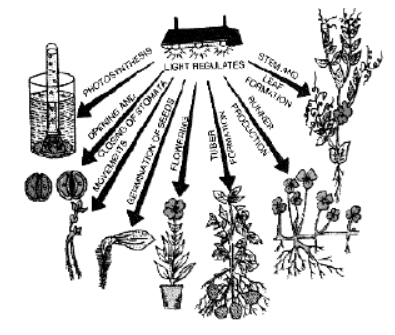
Fig. : Various effects of light upon a green plant
Heating action Exposure of parts of the plants to light raises their temperature, which effect their related processes.
Effect on transpiration rate Indirectly light affects transpiration rates through increase in temperature. Transpiration ratescorrespondingly affect water absorption also. Thus high light intensities are always associated with dry habitats and high transpiration rates.
Stomatal movement Opening and closing of stomata is regulated by light. This is thus related to transpiration and absorption.
Distribution of plants Light conditions at poles are different from other parts of earth. Thus total amount of radiation received by the earth’s surface differs with latitude (distance from the equator). This may be one of the reasons for differences in the vegetation at poles and at other parts of the earth. Briefly the quality (wave length), the intensity (energy measured in Joules) and duration (length of day) of light are important to organisms. The intensity of light varies with latitude and time of the day. Light also affects the process of photosynthesis, growth and reproduction in plants. The quality of light plays an important role in flower induction, seed germination and plant movements. The duration of light regulates the phonological processes, such as flowering and fruiting in plants.
EFFECTS OF LIGHT ON AQUATIC SYSTEM
Life activity under water is often determined by the availability of water. Light is a limiting factor for plants in deep waters, such as in oceans and deep lakes. In aquatic systems presence of light determines where producers and consumers live in water.
On the basis of availability of light deep lakes are divided into following vertical zones :
- Littoral zone: This is the shallow water zone around the edge of the lake which supports rooted vegetation. Light penetrates through this zone.
- Limnetic zone: The open water zone beyond the littoral zone, where phytoplankton grow in abundance, in this zone, depending upon clarity of water light may penetrate upto 20 to 40 m.
- Profundal zone: The dark zone where light does not reach, is known as the profundal zone. The profundal zone is generally absent in ponds. The sediments of the bottom of lakes and ponds forms the benthic region which is a habitat for benthic organisms like snails, slugs and micro-organisms.
TEMPERATURE
Temperature is the degree of hotness or coldness of a substance. The factors which influence variation in temperature include latitude, altitude, topography, vegetation and slope aspect. The vertical temperature gradient over earth’s surface is called lapse rate, the value being 6.5ºC per 100 m elevation. Temperature has a significant effect on the climatic conditions, growth response of plants, and activities of organisms. Temperature may act as a stimulus for plant, determining the timing of their development. For example, thermoperiodism (a day-night temperature differential) is essential for optimum growth of some plants. Exposure to cold enhances seed germination, as well as induces flowering in some plants.
THERMOREGULATION AND HOMEOSTASIS
In controlling the rate of process inside an organism and also its activities, temperature is very important.
Animals are divided into 2 types based upon their thermoregulation. They are :
- Ectotherms
- Endotherms
Ectotherms (cold-blooded animals) The body temperature tends to match with the environmental temperature in which they live. e.g. Frogs and snake. They control their body temperature by moving around or by seeking shade. Some ectotherms behave as nocturnal and they feed during the night.
Endotherms : The birds and mammals have constant body temperature and are called homeothermal or endothermic or warm-blooded animals to ideal with temperature extremes. This is achieved through evaporation of water from their bodies during summer and through insulating action of fur, feathers, fats etc. during cold weather of winter months; conservation of body heat by a layer of paniculus adiposus of subcutaneous zone especially in whales, seals, polar bear and elephants; erection of hair by arrector pili muscles to trap more air and constriction of superficial blood vessels. In these animals, hypothalamus acts as a thermostat.The maintenance of relatively constant internal environment under varying external environment is called Homeostasis. Temperature changes also induce certain behaviour patterns e.g. thermotaxis (i.e. orientation towards heat). Thicks locate their warm blooded hosts; rattle, snake vipers etc. can detect their prey by their body heat.
THERMAL STRATIFICATION IN LAKES
In deep aquatic systems, due to differences in temperature of water at varying depths leads to thermal stratification. A zone of slow change in temperature is called thermocline. During summer, surface water bears a higher temperature, which is separated from deep water by thermocline. Two layers are distinguishable due to thermocline.
Epilimnion: It represents upper layer of water. In temperate lakes, water is at freezing temperature on surface, in winter season. This water is cool in autumn and warm in spring. This leads to free mixing of water in aquatic system and is called as spring turn over. This leads to redistribution of oxygen and nutrients leading to excessive growth of phytoplankton.
Hypolimnion: It represents the lower layer of water body and temperature is about 4ºC during winter in temperate lakes. Due to stratified condition in summer and winter, growth of phytoplanktons is highly regulated due to less supply of oxygen and nutrients.
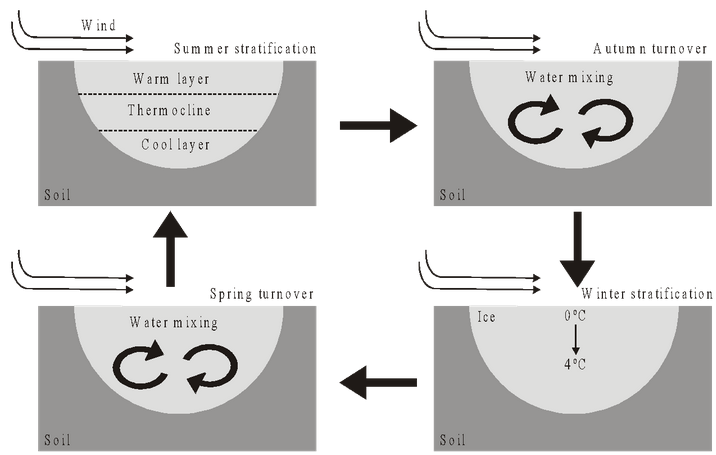
Fig. : Thermal stratification occurs in lakes.
The seasonal mixing patterns of a temperature lake are determined by its temperature profile.
WATER
Water is essential for life. It covers more than 70% of the earth’s surface. The chief source of soil water is atmospheric precipitation. It may occur in the form of snow, rain, hail, sleet, frost, dew, fog or mist. About 45% of water flows into rivers, 20% percolates into soil and 35% lost by evaporation. Melting of snow and ice are also important sources of water. Land plants derive water from the soil while the land animals derive water from pools, ponds, lakes, rivers, springs etc.Water regulates the climate through its role in rainfall distribution and temperature moditification. It has significant effect on vegetation type and its composition.
HYDROLOGICAL CYCLE
Hydrological cycle represents the movement of water between aquatic systems, air and land. Water is indispensable constituent of life, 60-90% of body weight is made of water. It is essential for solubilization of chemicals, molecules, for chemical reaction and transport materials. Oxygen is also derived from photolysis of water during photosynthesis.
There are two overlapping water cycles
- Global water cycle
- Local water cycle
Global water cycle It consists of evaporation and precipitation. One estimation puts world precipitation at 4.46 × 1020 g/yr.
It is three types:
- rain
- snow
- hail
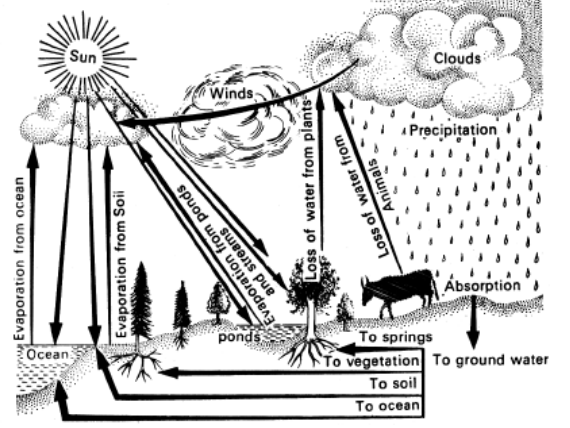
Fig. : Diagram showing global water cycle
Water vapours present in atmosphere is about 0.13 × 1020 g. Water vapour subsequently cools and condenses to form clouds and water. Water comes down to earth as rain and snow or may drop into oceans. If it falls on land mass, it again flows back into the sea and oceans from rivers and underground water. Rainfall is uneven at different places of earth. Cherrapunji gets >11,000 mm rainfall every year when compared with desert receiveing < 100 mm year–1 each year.
Smaller cycle (Local cycle) It consists of entrance of environmental water into the living system and its return. Aquatic animals absorb water from surroundings and excrete it. After the death of organisms water returns to the surrounding medium through process of decay. Land animals take in water either direct from fresh water or through food. Plants absorb water from soil. Evaporation of water from trees cools the surrounding air and determines microclimatic condition of the area.
Plant-water Relations
Water availability of land plants depends upon soil water which in turn depends upon rainfall or melting of snow. The upper limit of water availability of a soil is called field capacity.
The water potential of a soil at field capacity is around –0.01 MPa. The lower limit of water availability in soil is known as wilting point having a water potential of –1.5 MPa. With increase in the negative values of water potential the water availability to plants is reduced.
SOIL
Soil (L. Solum–earth material in which plants grow) is the uppermost weathered layer of earth’s crust and is composed of minerals and partly decomposed organic matter. Plants get their food and water from the soil. The root hairs of plants adhere to the soil particles and absorb water. The soil develops from the rocks. The process of breaking up rock into smaller particles is called weathering. There are several causes of weathering. Under mechanical weathering, fluctuations of temperature cause contraction and expansion of the rocks and they break. Due to strong wind velocity these broken portions fall down and are converted into smaller particles. The run-away water breaks these particles into smaller ones. The process of soil development is called pedogenesis. It is more active in superficial layer of earth. The study of soil is called Pedology. Soil is not a single factor but is a complex of several soil factors, collectively called the soil complex.
SOIL TYPES
There are several systems of soil classification.On the basis of the mode of their formation, particularly the nature of the origin of mineral matter, soil are classified as :
- Residual soils
- Transported soils
Residual soils : Residual soils are those in which the whole process of soil formation that is weathering and pedogenesis occurs at the same place. Thus in these soils formation occurs at a place where their parent matter (rock) is present.
Transported soils : Soils are those where the weathered material is taken away at other places. This is at these different places, where through pedogenesis, soil formation is completed. The weathered matter may be taken away to other places by several agent.
- Alluvial : transported by running water (mainly river water)
- Colluvial : transported by gravity are also called Terai soils
- Eolian : transported by air
- Glacial : transported by slipping of glaciers
On the basis of the nature of parent matter and climatic conditions differentiate, three major types of soils namely
- zonal
- interazonal
- azonal
Four types of soils are found in India
- red soils
- black soils
- alluvial soils
- colluvial soils.
SOIL PROFILE
The soil layers distinguished on the basis of colour, hardness and other tangible properties are called as horizons. They are exposed by excavation from the surface to the parent rock material. The study of these superimposed horizons constitutes the soil profile or the vertical layered structure of soil is called Soil profile. As many as five horizons are differentiated which are designated as
- horizons O
- horizons A
- horizons B
- horizons C
- horizons R
Horizon O : It is the uppermost horizon present above the mineral matter. It is largely composed of fresh and/or partly decomposed organic matter. As many as two zones are differentiated in this horizon namely O1 and O2 (earlier designated as A00 and A0 respectively). This horizon is well developed in forests but poorly developed in grasslands and almost absent in desert.
Horizon A : It is the uppermost mineral horizon of the soil. From this layer the mineral like Fe, Al are generally washed downward and hence it is called eluvial zone (and the phenomenon as eluviation). It is sub-divided into zones designated as A1 and A2 (and sometimes A3). While A1 is dark coloured and rich in organic matter, A2 is light coloured and has little organic matter. A3 is a transitional area between A and B horizons.
Horizon B : It is the second mineral horizon in which the minerals accumulate and hence it is called illuvial zone (the phenomenon as illuviation-redeposition of materials). It is made up of dark coloured, coarse textured particles. Sometimes it is also differentiated into three zones named as B1, B2 and B3. The two horizons A and B together constitute the solum. The solum along with the horizon O forms the top soil.
Horizon C : It is made up of incompletely weathered, large rock pieces which have not yet undergone, the process of pedogenesis. It is also called sub-soil. If weathering is fast, this horizon is poorly developed.
Horizon D or R : It represents unweathered parent rock material or the bed rock. It forms the base of soil profile.
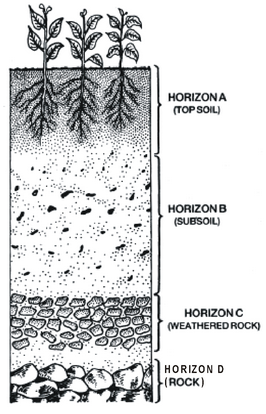
Fig. : Soil Profile
SOIL MATURATION
Due to interaction of several factors, the process of soil formation is completed. The soil becomes mature and well stabilised due to occurrence of the following processes :
- Melanization
- Podsolization
- Laterization
- Gleization
Melanization The mixing of humus with the mineral horizon A is called melanization. As a result, the soil becomes darker in colour.
Podsolization In temperate zones having high humidity and low temperature, there is formation of litter with low mineral contents. These minerals leach from humus and through horizon A, they get precipitated in horizon B as a hard distinct layer. Consequently, the horizon A appears to be some what light coloured. This process is called podsolization and the soils so formed as podsols
Laterization This is more a geological phenomenon seen in tropics having high temperature and high rainfall. There is loss of silica minerals and synthesis of Fe and Al-oxides which get precipitated. As a result, a red coloured soil is formed which is different in organic matter. This process is termed as laterization and the soils as laterite soils.
Gleization Under very cold and humid environment, water logged conditions develop due to raising of water level. As a result, a blue-grey coloured zone is formed at the bottom of the solum due to ferrous compounds and slow decomposition of organic matter. This process is called gleization and the soils so formed as gleys.
SOIL PROPERTIES (SOIL COMPOSITION)
The soil is a complex organization being made up of some six constituents namely inorganic matter, organic matter, soil organisms, soil moisture, soil solution and soil air. Roughly, the soil contains 50-60% mineral matter, 25-35% water, 15-25% air and a little percentage of organic matter.
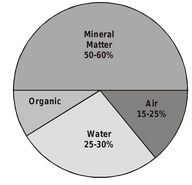
Fig. : Approximate proportions of the main soil components
Inorganic matter The mineral component constitutes some 50-60% of soil. It is present in the form of particles of different sizes. Accordingly, they have been identified as gravel, sand, silt and clay. The Atterberg’s system identifies two types of sand particles as coarse and fine. On the other hand, the British standards recognises three types of sand particles namely coarse, medium and fine. We shall follow here the Atterberg’s system which designates soil particles in the following manner.
- Gravel - Bigger than 2.0 mm.
- Coarse sand - Between 2.0 and 0.2 mm.
- Fine sand - Between 0.2 and 0.02 mm.
- Silt - Between 0.02 and 0.002 mm.
- Clay - Smaller than 0.002 mm.
The relative proportion of soil particles determines the soil texture. A soil having more of gravel and sand is said to have a coarse texture and the one having more of silt and clay is said to have fine texture. A soil having sand, silt and/or clay in a specific proportion is called loam. It is the best soil for plant growth. Depending upon the percentage of various components, several textural groups of soil have been recognised. While loam has 50% and + 50% silt and/or clay, the silt has about 90% silt + 10% sand. The clay components of the soil is generally measured by the plummet balance method. The specific arrangement of soil particles is called soil structure. The permanant aggregates of soil are called peds and the disturbances caused by ploughing and digging forms clods. The tiny soil units aggregate and collectively impart a specific shape such as prism like, platy, spheroidal and block like.
Organic Matter The organic matter present in the soil is contributed by the death and decay of living organisms i.e., plants and animals. It is present in various forms designated as litter, duff and humus. The undecomposed organic matter is called litter. It decays slowly and when it is partly decomposed, it is called duff. Fully decomposed and finely divided, amorphous organic matter which has become mixed with the mineral matter is called humus. Chemically, the humus contains carbohydrates, sugar alcohols, lipids (fats, oils and waxes), tannins, resins, lignin, amino acids, proteins, purines, pyrimidines, flavonoids, alkaloids, carotenoids, etc. By composition it contains 55-60% carbon, 35-40% oxygen, about 5% hydrogen and roughly 5% nitrogen. The conversion of litter into humus is termed as humification whereas breaking of humus into minerals, CO 2 and water as mineralization.
The decomposition of litter is brought about the interaction of soil organisms. The mineral nutrients so released may be involved in the synthesis of complex new organic compounds. High soil biomass is formed under humid climate, at soil pH ranging between 5-8, intermediate temperature (17º – 27ºC) and good drainage conditions. Under conditions of arid climate, high or low soil pH, extremes of temperature and poor drainage, low soil biomass is formed.
Soil Organisms A number of organisms live inside soil. They include bacteria, actinomycetes, fungi, algae, parts ofhigher plants, protozoa, rotifers, nematodes, insects, earthworms, molluscs and burrowing vertebrates. They are the living components of the soil. Ecologists differentiate the various soil organisms into mictroflora, microfauna, macroflora and macrofauna.
The important functions of soil organisms are as follows :
- Decomposition of organic matter and release of inorganic nutrients for recycling. Organic matter is first acted upon by detrivorous soil fauna ( e.g. , termites, carpenter ants, crabs, insect larvae, earthworms, millipedes, molluscs).The fragmented matter is then acted upon by microorganisms, e.g., bacteria, actinomycetes, fungi. This releases inorganic nutrients. They phenomenon is called mineralisation. Some microorganisms also change the released raw materials into useful form e.g., sulphur bacteria (H 2 S → SO 4 ), nitrifying bacteria (NH 3 → NO 3 ).
- A number of free living bacteria and blue green algae take up gaseous nitrogen and change the same into organic form of nitrogen. The process is called the nitrogen fixation. e.g. , Azotobacter, Nostoc, Anabaena.
- Microorganism convert organic matter into humus. Humus is highly useful for maintaining crumb structure, sponginess, aeration and hydration of soils. It also provides growth stimulants to plants.
- Earthworms and insects help in soil mixing, maintenance of soil porosity and soil fertility.
- Decaying roots of plants and burrows of small animals, produce passages in the soil for flow of water and air.
- A number of diseases are caused by soil borne bacteria, fungi and nematodes.
- Burrows of large animals are a source of loss of soil moisture. The soil near the burrows becomes loose and infertile.
Soil Moisture (Soil Water)
It is one of the most important ecological factor in the distribution of biota. Soil miosture is derived from rain. In crop fields irrigation is another source of soil water. A part of rain or irrgation water flows over the soil as run-away water and a part percolates downwardly to water table. The latter is called gravitational water.
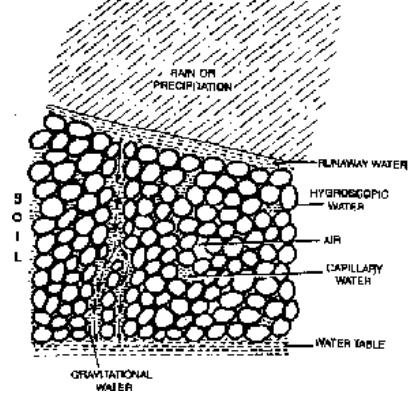
Fig. : Types of soil water
Water held in soil is of four types
- Hygroscopic water : It is the water absorbed or imbibed by the soil colloids. It is not available to the plants as the water is held very firmly by the soil particles.
- Water Vapours : They occur in the soil atmosphere to make the latter saturated. Though not available to the plants, a component of this water condenses during night so as to wet the areas dried by evaporation.
- Combined water : The water occurs bound up in chemicals and is thus unavailable.
- Capillary water : It is water present inside micropores. It is the water available to plant roots. The content of capillary water depends upon soil texture.
Soil air
It is essential for roots and soil organisms. In a good soil 25% of total volume of the soil is filled with air. Composition of soil air depends upon ventilation or number of macropores connencted with soil surface. Soil air is generally richer in carbon dioxide. Oxygen content is less than normal. However, low oxygen content is harmful. 5–10% of oxygen is essential for root. Below this they get killed. Water absorption occurs in root only when oxygen concentration is more than 10%. Reduced oxygen content kills aerobic organisms. As a result, mineralisation of decaying organic matter is impaired. Environment of the root becomes reducing. It produces a number of toxic compounds. Heavy metals and silica solubilise resulting in toxic effects.
Fire
The phenomenon of fire existed before the human race came into existence.There seems to be two main reasons for the creation of all types of fires on this earth :
- Physical causes : They include volcanic activities, lightening, excessive sun heating and friction.
- Biological causes : They may be natural such as the one created by microbes and the other created by human beings.
KINDS OF FIRE
The fires are of three types :
- Ground fire : They arise at places where organic matter is heated up and the litters catch fire. Such fires are subterranean, flameless and continue for a long period smouldering the organic matter. As a result, dehumification of the soil takes place. The ground fires are thus biological in origin.
- Surface fire : They are also of biological origin. Its low flame engulfs the litter fallen on the ground from the trees. It destroys not only the seedlings, herbs, shrubs but may also scorch the tree bases.
- Crown fire : It is the most destructive fire, generally caused by some physical reason. It not only destroys the tree tops (canopies) but also the entire vegetational cover. On account of this fire, the temperature of the area under fire may rise upto 700ºC.
EFFECTS OF FIRE
Due to fire, the vegetational cover is destroyed upto various extents. The fire causes changes in biogeochemical cycles operating in the ecosystem. As a result of fire the competition is either reduced or completely eliminated. After fire, the fire tolerant species spread whereas the fire-sensitive species are destroyed. There is stimulation of growth of some plant species like Populus tremuloides and Epilobium angustifolium. Many other plants like Cynodon dactylon, Aristida stricta, Paspalum notatum, Sporobolus curtisii etc. are stimulated to produce a large number of seeds.On the burnt land a new type of plant succession is initiated. The land is initially colonised by such forms which prefer to grow on burnt soil. Such forms are described as pyrophilous e.g. Pyrola (angiosperm), Pyronema (fungus).
BIOTIC FACTORS
Nature contains large number of organisms and these organisms i.e., both flora and fauna, influence vital reactions of one another. The various vital functions such as growth, movements and reproduction depend upon mutual relationship between individuals. This relationship may be intraspecific or may be interspecific. When different types of population (units of biotic factor) live together, they form a biotic population. The individuals of the same species growing in the same area exhibit an acute competition for food, light water and shelter and triggers, the intraspecific competition which is not severe. So the biotic factors include floral components, faunal components and microorganisms. The living species may be the producers ( e.g. green plants of food or consumers, including herbivores, predators, parasites or omnivores. Species may have positive, negative or neutral effect on population growth and well being of other species.





